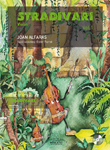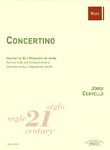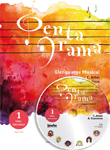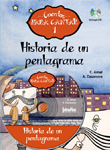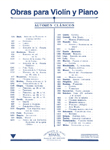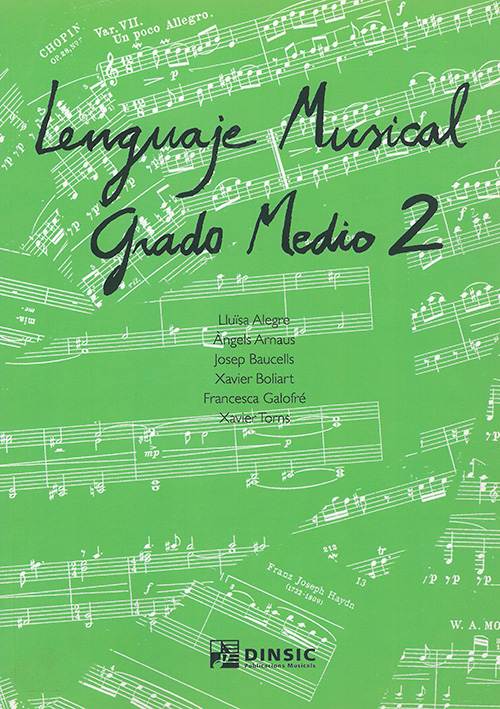WORKS
- Genre
-
Musical education
- Choir
- Counterpoint
- Dictation
- Direction
- Exam study manuals
- General music pedagogy
- Harmony
- Hearing
- Illustrations / Posters
- Improvisation / Sight reading
- Instrument methods
- Instrument pedagogy
- Instrumental study repertoire
- Instrumentation and orquestration
- Musical language
- Solfège
- Templates
- Theory and analysis
-
Incidental music
-
Lined paper
-
Flamenco
-
Religious music
-
Classical / contemporary
-
Modern music
-
Folk music / traditional
-
Musicology
-
Divulgation
-
Games and hobbies
-
Music therapy
-
Children / Youth
-
- Instruments
- Ensemble
- Difficulty level
- Period
- Genre
SOPORTE
Search
Find here: books, scores, composers, digital pieces, cd's
Best-selling works
Our classics
Newsletter
I wish to be informed of the news about your music
We have received your e-mail correctly
Multimedia
Lenguaje Musical 2 Grado Medio
Lenguaje musical
BOLIART, Xavier; BAUCELLS, Josep; GALOFRÉ, Francesca; ALEGRE, Lluïsa; ARNAUS, Àngels; TORNS, XavierBOLIART, Xavier; BAUCELLS, Josep; GALOFRÉ, Francesca; ALEGRE, Lluïsa; ARNAUS, Àngels; TORNS, Xavier...[-]BOLIART, Xavier; BAUCELLS, Josep; GALOFRÉ, Francesca...[+]Reg.: DI0059
21,50 €
P.V.P. (VAT included 4%)
Add to cart
- Ensemble: Solo.
- Genres: Musical education: Musical language; General music pedagogy.
- Language: Español / Castellano
- Product format: Libro
- Difficulty level: Elementary-intemediate
- Period: 2nd half S. XX - XXI
- Publishing house: Dinsic
- No. of pages: 128
- Measure: 29,70 x 21,00 cm
- ISBN: 978-84-86949-98-3
- Available in digital: No
- Available for rent: No
Rhytm: Revision of previous course; simple time signatures with denominators of 4 and 2, and compound time with denominators of 8, 4 and 16; common amalgamated time signatures (5/4, 7/4, 15/8 and 21/8); time signatures of 'unequal time' (5/8 and 7/8); changes in time (simple-compound and vice versa); movement changes; harmony-readings in 1 and 2 staves; duplet, quadruplet, quintuplet and septuplet; asymetric accents. / Intonation- ear training: revision of tonalities; 4 alterations; series of intervals without tonal reference; exercises (memorization; dictations; scales; transposing 2nd and 3rd superior and inferior.); readings with clef changes; readings(changes in mode- homonymous keys-; up to six alterations; modulation to neighbouring and distant tones; modulation to the Dominant; polyphony); augmented 5th diminished 7th; mode changes in different keys; cadences; enharmonics; Major mixed scales; minor mixed scale; chords- 7th M-m-dim./ Harmony: tonal functions ( I-IV-V/ I-IV-V-V7/ I-IV-V-V7-II-VI); types of cadences ; blending 4 voices; special notes (grace notes, appogiaturia, etc.); Dominant 7th (root form, 1st and 2nd inversion); figured bass. / Analysis: binary-ternary; analyisis of phrasing; cadencial analysis; variations on a theme; odd notes; modern suite; instrumental clefs; etude; nocturne; prelude; sonata; coda; concerto; orchestra; solo and transposing instruments; symphony; little fugue.
Eight units, each containing six topics: reading, exercises, rhythm, ear training-entonation, harmony and analysis, and creativity. / Piano accompaniments for the reading exercises. / Programme guideline for the course and revision of theory in appendix.

